Horse Racing Betting Odds Explained
If you are a fan of horse racing and thinking about starting to bet on your most preferred horse, knowing the basics of how horse racing betting odds work is necessary.
To put it modestly, horse racing odds are just several numbers that act as the mathematical illustration of the probability a horse has of winning a race. So, the racing betting odds that come along with a single horse present the likelihood of him winning but also calculate your chances of winning if you bet on that particular horse.
Horse betting odds can be represented in different formats and variations, and they actually give punters valuable insight into the underdogs and favourites of a certain racing event.
Once you learn how to read these odds, keep them up to date according to the latest happenings in the industry, and search for the best ones offered – both online and at a race track – you’ll be one step closer to ending up with a winning bet slip.
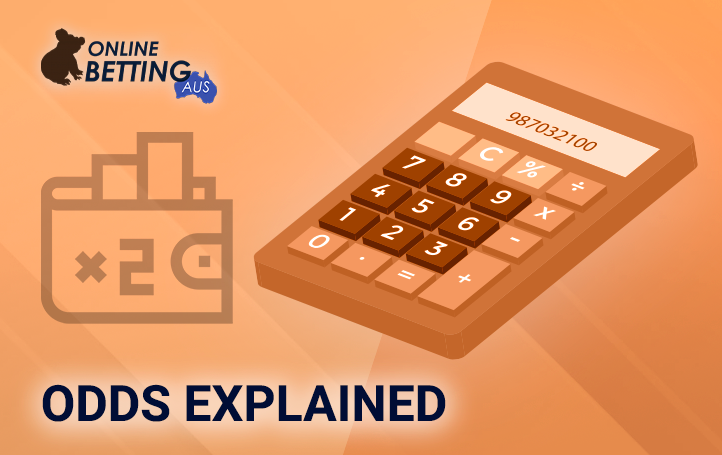
What Are Horse Racing Odds?
Horse betting odds are numbers that define how much of a return you can potentially get, depending on the amount of wager you place. These odds also portray the probability of a horse winning the race and also directly influence your potential payout.
If a runner has just a slight chance of winning, its odds will be higher, meaning that if you place a bet on it, you can get a potentially larger sum of money as a return. On the contrary, if the runner is among the favourites, the chances of it winning increase, which means odds will be lower, thus bringing a lower payout.
Whatever the case, rookies need to understand the basics of odds before proceeding to bet, which is why we have horse racing odds explained throughout this article.
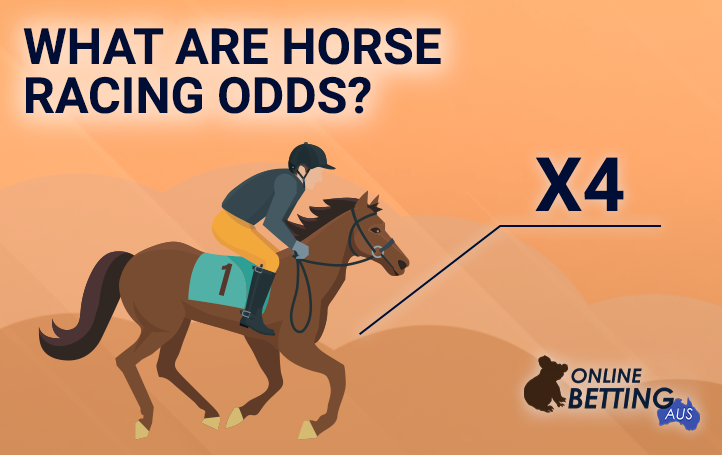
How Horse Racing Betting Odds Work
When it comes to horse racing betting, bookmakers can present the odds in several formats, fractional, decimal, or American being the most popular ones.
To keep it simple, we’ll elaborate on how fractional odds on horse races function.
A typical representation of odds is the following – 13-2. The first number represents the units you have a chance to win, while the second one presents the units you must put at risk in order to get the payout. This example shows odds that would be placed along with an underdog, which means that if the first number is larger than the second, your potential payoff will be bigger but riskier.
On the other hand, if you have 1-6 odds, this means that you have the possibility of winning one unit while wagering 6 units. This is what betting on the favourite runners looks like, and it happens because many Aussie bettors place bets on that particular horse, which makes a bet less risky but comes with a lower payout.

Traditional Odds in Online Horse Betting
Fractional odds in horse racing betting are used most frequently by bookies, and this can be represented in the following format – 5 -1.
This number shows the relationship between the profit and the wager, the former is the profit, and the latter is the amount you wager. So, for a stake of AU$10, you can get AU$60, getting an AU$50 profit. The final payout is a multiplication of the first number and the stake (5 x AU$10) + the wagered amount, which equals AU$60.
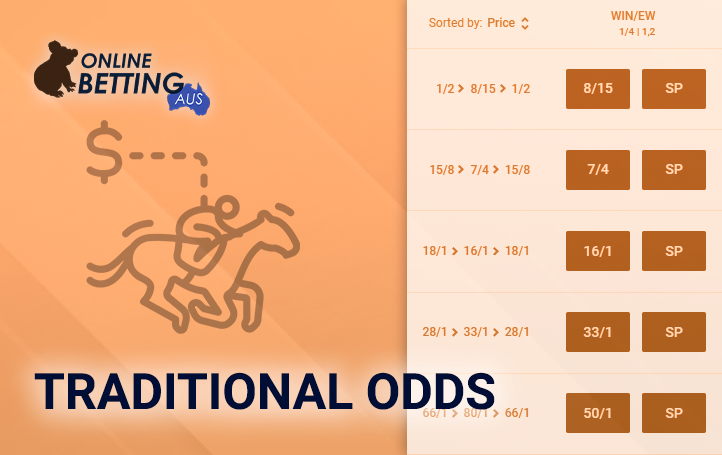
Pari-mutuel Pool Betting Payoffs
The pari-mutuel system is typical for horse racing, and the main difference between sports and horse racing is that in horses, punters are betting against one another, not against the ‘house.’
These accumulated win, place, and show bets, which are the most common types, make up the pool that is actually all the money placed on a certain win, place or show market.
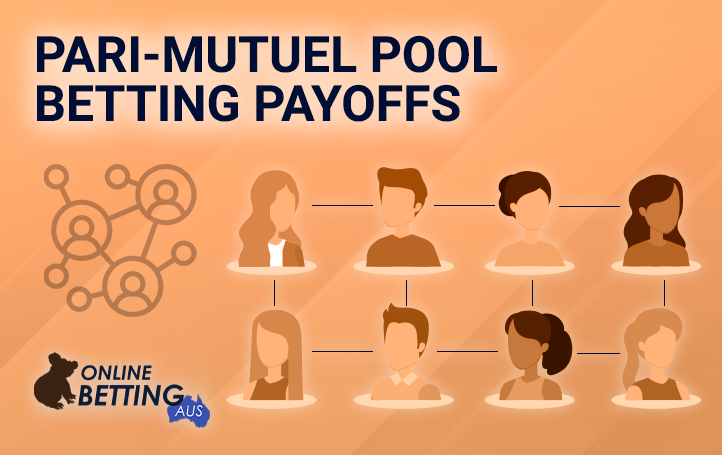
Exotic Wagers
Besides the standard win, place, and show wagers which are the best to start with, veteran punters choose exotic types of bets that involve more expertise in the field, such as the exacta, trifecta, and superfecta.
Placing an Exacta bet means that you need to predict which horse will end up first and second in the correct order. The same goes for Trifecta, with the difference in predicting the outcomes of three horses, while the Superfecta includes four horses in their correct order.
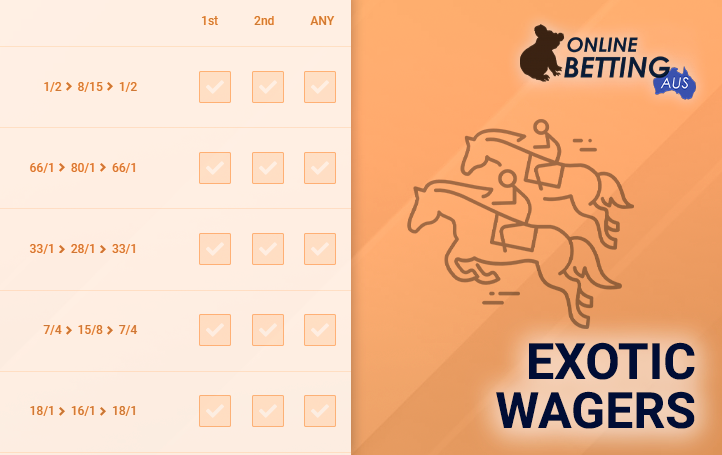
Boxing Your Horse Bets
Horse odds in racing are highest when you box an exotic bet. When you decide to box an Exacta bet, it actually means you’d need to double the stake, as this way, you are covering all the possible outcomes of the two horses involved in your exacta.
If you have placed a Trifecta, for instance, and you want to box it, then you should cover all the possible finishing positions of all three horses involved, which are actually 6. This means that you should place six bets in total.

Common Horse Racing Betting Payouts
The payout depends on the minimum amount wagered and the odds in racing. The most acceptable minimum stake at most land-based and online bookmakers is AU$1, although there are some who require and still do a minimum of AU$2 for some types of bets.
In the following table, we will present the potential payout for a stake of AU$1, including the original stake, associated with the most common odds in horse racing.
| Odds | Payout (stake + profit) |
|---|---|
| 1-10 | AU$1.10 |
| 1-5 | AU$1.20 |
| 7-2 | AU$4.50 |
| 9-5 | AU$2.80 |
| 15-2 | AU$8.50 |
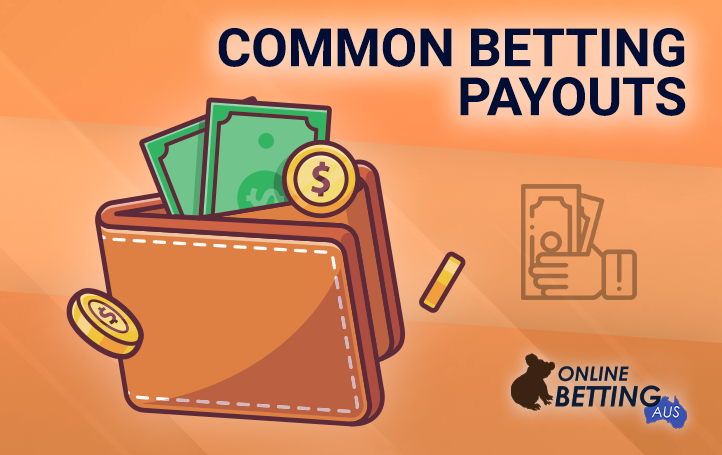
Calculating Horse Racing Odds
Calculating the profit or the whole payout before placing the bet can be done by following a simple formula that involves the initial stake and the horse betting odds.
To find out the potential win, you need to multiply the amount you wish to wager with the first number in the fraction of the odds. The outcome of the equation is the profit you will gain, and by adding the initial stake, you’ll get the whole payout. Here’s an example of how calculating odds on horse races functions.
- Imagine the odds are 5-1, and you want to wager AU$2;
- Then, 5 x AU$2 = AU$10, which is the profit number.
- When you add your initial stake, AU$10 + AU$2, it becomes a total payout of AU$12.
The maths gets a little bit more complicated if you deal with 7-4 or 5-3 odds in horse racing. The easiest way to do this is to follow the same formula, which involves multiplying your stake with the first number in the fraction and then dividing the outcome with the second number. Keep in mind that this will show only the profit without adding the initial stake for the total payout amount.

Horse Racing Morning Line Odds
Bookmakers deal with setting the basis to start horse racing betting by presenting the primary morning line odds to the public.
The morning line odds have mostly to do with the bettors’ inclinations and affections towards the horses. The bookmaker’s job involves assessing the public’s opinion and setting the grounds in order to give a hint to bettors about what to expect when the lines open. This also involves predicting which horses are going to be the favourites among punters and which will settle as the underdogs so that the odds can be placed correspondingly.
Setting these morning line odds includes observing how well the runners performed in the past and also determining which horses are going to get the most or the least number of bets from fans. These odds are set before the race starts, at the very beginning, and can fluctuate at post time.

Decimal Horse Racing Odds
Some online horse betting sites or racetracks display the odds in a different format mentioned above, which are called decimal odds. For Australian punters who already know how to read the fractional odds, these would be much easier to interpret.
Decimal odds don’t involve fractions, and they are simply calculated – the amount of your stake is multiplied by the displayed number, thus giving the total payout.
For instance: Betting on odds of 6.0 with AU$50 will result in AU$300.
The smaller the number, the lesser the potential payout and profit, which means that you are definitely wagering on a favourite. However, if you see odds of 50.0, 60.0, or above, your payout will be much larger but also involve higher risk because of the obvious longshot involved.
The main difference between fractional and decimal odds you should always have in mind is that the number you get after multiplying the decimal and the stake always includes your initial wager, so you are looking at a final, total payout.
For example, a stake of AU$20 x 5.0 = AU$100 (both profit and stake included in this final number).

Betting tools you need at the horse races
The whole excitement of the race you are about to attend can make you just forget about all the essential tools you will definitely need as an avid spectator and a punter.
That’s why we at OnlineBettingAUS are here to remind you of these betting tools and explain the reasons why you need these more than you think you do.
- An informative leaflet of the racetrack – This short pocket programme of the racetrack will give you insight into all the information you need to know regarding the horses, their current condition, their jockeys, trainers, and the whole team involved. The average price of these leaflets is AU$3.
- The DRF – The Daily Racing Form is a much-needed informative brochure that offers essential information on all the horse participants in today’s race. You can read about their past behaviours and performances and handicapping. The average price is around AU$4.
- Public choices of handicappers – If you pay around 50 cents, you may read daily horse selections by handicappers in your local paper in case you are betting online or cannot attend the event live at the racetrack.
- Tips by handicappers – For a very low price of around 50 cents, you can get a hold of several papers that include very helpful tips which are published by handicappers at the racecourse.
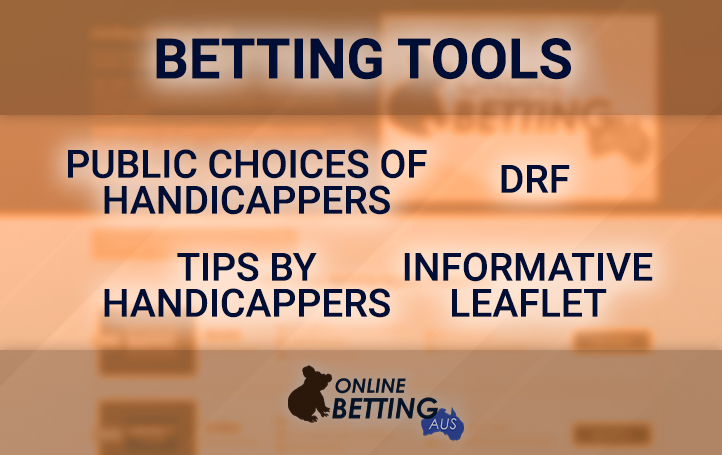
Types of horse racing wagers
When you explore the odds in racing and are ready to make a bet, the final decision is – which type of bet? There are several kinds of horse racing wagers you can place; some are more suited for the rookies, such as the standard win place and show, while the exotics are dedicated to the more expert punters.
In the table below, we’ll present useful information on the kinds of horse racing betting wagers, what each of them involves, and how likely you are to win if you place any of them.
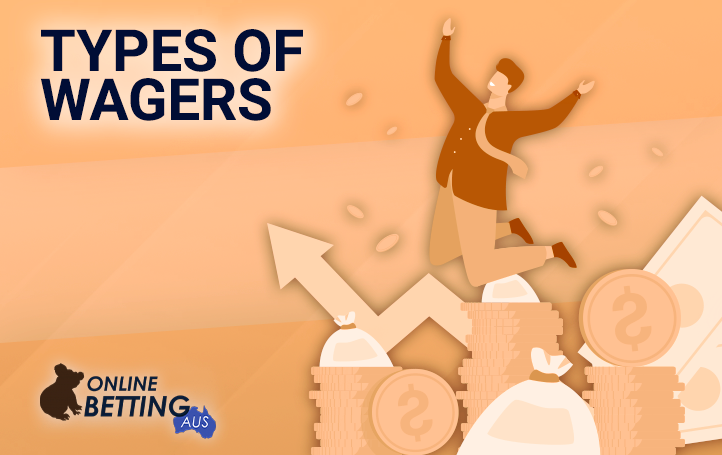
| Bet Type | Explanation | Winning Potential |
|---|---|---|
| Win | To win, your selected runner must end the race 1st. | Medium |
| Place | To win, your selected runner must end the race 1st or 2nd. | Good |
| Show | To win, your selected runner must end the race 1st, 2nd, or 3rd. | Great |
| Quinella | To win, you include two horses that must finish the race 1st and 2nd, regardless of the order. | Medium |
| Exacta | To win, you include two horses that must end the race 1st and 2nd by predicting the correct order. | Difficult |
| Trifecta | To win, you include two horses that must end the race 1st, 2nd, and 3rd, by predicting the correct order. | Very difficult |
| Superfecta | To win, you include two horses that must end the race 1st, 2nd, 3rd, and 4th, by predicting the correct order. | Extremely difficult |
| Daily Double | To win, your selected horses need to win two successive races. | Difficult |
| Pick 3 | To win, your selected horses need to win three successive races. It’s a combination of a daily double + one simple win bet. | Very difficult |
| Pick 4 | To win, your selected horses need to win four successive races. | Extremely difficult |
| Pick 6 | To win, your selected horses need to win six successive races. | One-in-a-million hard |
